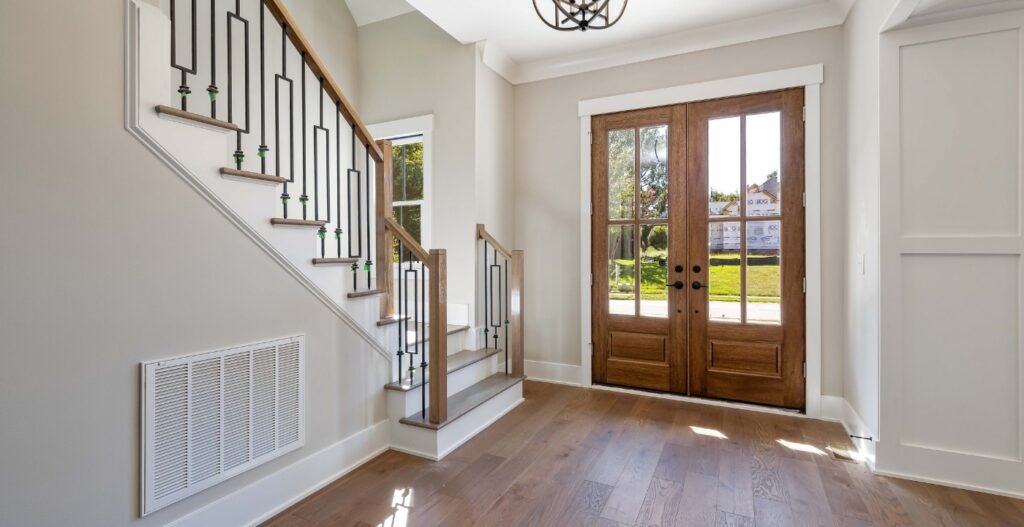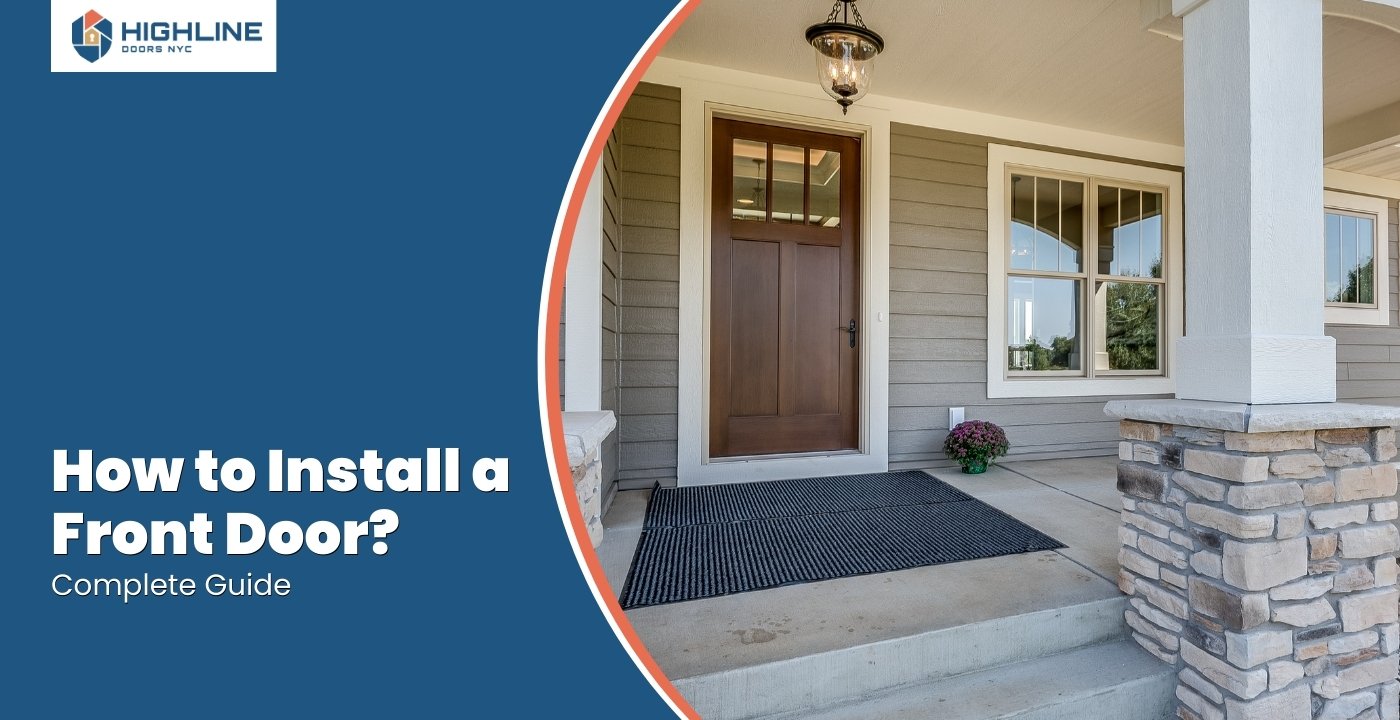A front door isn’t just an entryway—it’s the first thing people notice and the barrier between your home and the outside world.
A bad install? That means drafts, sticking hinges, or a door that never quite shuts right. But get it right, and you’ll have a secure, smooth-swinging door that looks great and lasts.
Here’s exactly how to do it, step by step.
Key Notes
- Measure the rough opening and check for level before installing the new door.
- Use shims to adjust alignment and ensure a secure, weather-tight fit.
- Apply flashing and caulk to prevent water damage and drafts.
- Secure the frame properly before installing hardware and insulation.
- Test the door’s swing and latch before making final adjustments.
1. Gather Necessary Tools and Materials
Before getting started on your front door installation, make sure you have everything you need to avoid unnecessary trips to the store.
Tools:
- Measuring tape
- Level
- Screwdriver or drill
- Hammer
- Chisel
- Circular saw (if adjustments are needed)
- Utility knife
- Pry bar
- Caulking gun
- Safety glasses and gloves
Materials:
- Pre-hung exterior door
- Shims
- Screws
- Exterior-grade caulk
- Low-expansion spray foam insulation
- Drip cap (Z-flashing)
- Paint or stain (if finishing the door)
2. Remove the Existing Door
If you’re replacing an old door, it needs to come out first. Work carefully to avoid damaging the surrounding structure.
Detach the Door
Start by opening the door slightly. Place a wedge underneath to keep it stable, then remove the hinge pins using a hammer and screwdriver.
Once the pins are out, lift the door off the hinges and set it aside.
Remove Trim and Frame
Using a utility knife, cut along the edges of the interior and exterior trim to break the paint seal. Then, use a pry bar to carefully remove the trim.
If you’re replacing the door frame as well, unscrew or pry the frame away from the rough opening.
3. Prepare the Rough Opening
A properly prepped opening ensures a secure and level installation.
Inspect and Measure
Check for any signs of water damage, rot, or cracks around the opening. If you find any, repair or replace the damaged wood before moving forward.
Then, measure the height and width of the rough opening to confirm that the new door will fit. There should be about ½ inch of space around the frame for adjustments.
Ensure Level and Square
Use a level to check if the sill, sides, and top of the opening are straight.
If needed, adjust with shims to create an even, plumb surface. A misaligned opening can lead to a door that sticks or won’t latch properly.

4. Install the Sill Pan
A sill pan protects against water damage by preventing moisture from seeping under the door.
Apply Sill Pan or Flashing
If using a sill pan, place it into the opening and secure it with screws or adhesive.
If you’re using flashing tape instead, apply it along the bottom edge of the rough opening, extending slightly up the sides.
Seal the Area
Run a bead of exterior-grade caulk along the top edge of the sill pan or flashing to create a watertight seal.
5. Fit the New Door
Now that the opening is ready, it’s time to position the new door.
Position the Door
Lift the pre-hung door and place it into the rough opening. Ensure that the bottom of the door sits securely on the sill pan.
If you’re working alone, use shims or temporary screws to hold it in place while making adjustments.
Secure Temporarily
Insert shims behind the hinge locations to maintain alignment, then drive a temporary screw through the hinge-side jamb to hold the door in place.
6. Level, Shim, and Secure the Door
Before fully securing the door, check that it is level and plumb.
Check Alignment
Close the door to see if it fits evenly within the frame.
If you notice any gaps or uneven spacing, adjust the shims accordingly. The gap between the door and frame should be even on all sides.
Final Fastening
Once the door is properly aligned, drive long screws through the hinge-side jamb and into the wall studs. Add screws along the opposite side as well, ensuring the frame stays in position. Trim off any excess shim material with a utility knife.
7. Install Exterior Flashing and Seal
A properly sealed door prevents air leaks and water damage.
Apply Drip Cap or Z-Flashing
A drip cap, also known as Z-flashing, directs water away from the door. Install it above the door frame, tucking it under the exterior siding or trim.
Seal Gaps
Apply a bead of exterior-grade caulk along the outer edges of the door frame where it meets the siding. This helps prevent drafts and moisture infiltration.
8. Insulate and Install Interior Trim
Sealing any gaps around the door frame will improve energy efficiency.
Insulate
Use low-expansion spray foam insulation in the gaps between the door frame and rough opening. Avoid overfilling, as excess foam can cause the frame to bow.
Attach Interior Trim
Once the insulation has set, reinstall the interior trim using finishing nails. If using new trim, cut it to size before attaching.
9. Install Hardware
Now that the door is secure, it’s time to install the handle, lockset, and other hardware.
Attach Handles and Locks
Follow the manufacturer’s instructions to install the door handle and lockset. Ensure that the latch aligns with the strike plate for a secure fit.
Test Locking Mechanism
Close the door and test the lock to confirm that it functions smoothly. Adjust as needed.
10. Final Adjustments and Finishing Touches
The last step is to make sure everything looks and works as it should.
Test Door Operation
Open and close the door multiple times to ensure it swings freely and latches correctly. If necessary, make small hinge or latch adjustments.
Paint or Stain
If the door is unfinished, apply an exterior-grade paint or stain to protect it from the elements. Allow it to dry completely before use.
Struggling With A Drafty, Misaligned Front Door?
Frequently Asked Questions
Can I install a new front door without removing the existing frame?
Yes, but only if the frame is in good condition and fits the new door properly. Otherwise, replacing it ensures a better fit and insulation.
What’s the best type of insulation to use around a front door?
Low-expansion spray foam works best because it fills gaps without warping the frame.
How do I fix a front door that doesn’t close properly after installation?
Check for uneven shims, adjust the hinges slightly, or sand down any high spots on the door.
Do I need special screws for securing a front door?
Yes, use 3-inch screws for the hinges and frame to anchor them securely into the studs.
How can I improve the security of my front door?
Install a reinforced strike plate, use a deadbolt with at least a 1-inch throw, and consider a security bar.
Should I paint or stain my front door before or after installation?
It’s easier to paint or stain before installation, but final touch-ups may be needed after fitting the door.
Conclusion
A well-installed front door does more than just look good—it keeps your home secure, blocks drafts, and operates smoothly for years to come.
From careful measurements and proper shimming to sealing gaps and testing hardware, every step plays a role in ensuring a snug, weather-tight fit. Rushing through installation can lead to misalignment, energy loss, or even long-term structural issues, so taking the time to do it right is worth the effort.
If your front door is causing more frustration than security, let us handle the job. We ensure a perfect fit, better insulation, and long-lasting durability. Book a free consultation today.



